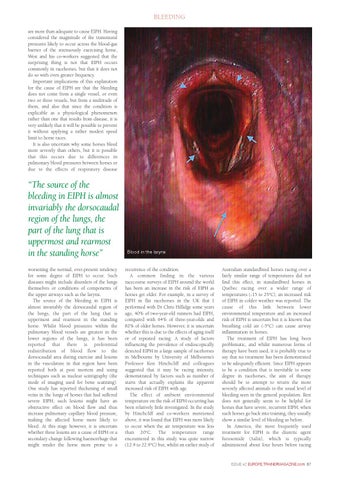BLEEDING are more than adequate to cause EIPH. Having considered the magnitude of the transmural pressures likely to occur across the blood-gas barrier of the strenuously exercising horse, West and his co-workers suggested that the surprising thing is not that EIPH occurs commonly in racehorses, but that it does not do so with even greater frequency. Important implications of this explanation for the cause of EIPH are that the bleeding does not come from a single vessel, or even two or three vessels, but from a multitude of them, and also that since the condition is explicable as a physiological phenomenon rather than one that results from disease, it is very unlikely that it will be possible to prevent it without applying a rather modest speed limit to horse races. It is also uncertain why some horses bleed more severely than others, but it is possible that this occurs due to differences in pulmonary blood pressures between horses or due to the effects of respiratory disease
“The source of the bleeding in EIPH is almost invariably the dorsocaudal region of the lungs, the part of the lung that is uppermost and rearmost in the standing horse” worsening the normal, ever-present tendency for some degree of EIPH to occur. Such diseases might include disorders of the lungs themselves or conditions of components of the upper airways such as the larynx. The source of the bleeding in EIPH is almost invariably the dorsocaudal region of the lungs, the part of the lung that is uppermost and rearmost in the standing horse. Whilst blood pressures within the pulmonary blood vessels are greatest in the lower regions of the lungs, it has been reported that there is preferential redistribution of blood flow to the dorsocaudal area during exercise and lesions in the vasculature in that region have been reported both at post mortem and using techniques such as nuclear scintigraphy (the mode of imaging used for bone scanning). One study has reported thickening of small veins in the lungs of horses that had suffered severe EIPH; such lesions might have an obstructive effect on blood flow and thus increase pulmonary capillary blood pressure, making the affected horse more likely to bleed. At this stage however, it is uncertain whether these lesions are a cause of EIPH or a secondary change following haemorrhage that might render the horse more prone to a
Blood in the larynx
recurrence of the condition. A common finding in the various racecourse surveys of EIPH around the world has been an increase in the risk of EIPH as horses get older. For example, in a survey of EIPH in flat racehorses in the UK that I performed with Dr Chris Hillidge some years ago, 40% of two-year-old runners had EIPH, compared with 64% of three-year-olds and 82% of older horses. However, it is uncertain whether this is due to the effects of aging itself or of repeated racing. A study of factors influencing the prevalence of endoscopically detected EIPH in a large sample of racehorses in Melbourne by University of Melbourne’s Professor Ken Hinchcliff and colleagues suggested that it may be racing intensity, demonstrated by factors such as number of starts that actually explains the apparent increased risk of EIPH with age. The effect of ambient environmental temperature on the risk of EIPH occurring has been relatively little investigated. In the study by Hinchcliff and co-workers mentioned above, it was found that EIPH was more likely to occur when the air temperature was less than 20°C. The temperature range encountered in this study was quite narrow (12.9 to 22.9°C) but, whilst an earlier study of
Australian standardbred horses racing over a fairly similar range of temperatures did not find this effect, in standardbred horses in Quebec racing over a wider range of temperatures (-15 to 25°C), an increased risk of EIPH in colder weather was reported. The cause of this link between lower environmental temperature and an increased risk of EIPH is uncertain but it is known that breathing cold air (-5°C) can cause airway inflammation in horses. The treatment of EIPH has long been problematic, and whilst numerous forms of therapy have been used, it is probably true to say that no treatment has been demonstrated to be adequately efficient. Since EIPH appears to be a condition that is inevitable to some degree in racehorses, the aim of therapy should be to attempt to return the more severely affected animals to the usual level of bleeding seen in the general population. Rest does not generally seem to be helpful for horses that have severe, recurrent EIPH; when such horses go back into training, they usually show a similar level of bleeding as before. In America, the most frequently used treatment for EIPH is the diuretic agent furosemide (Salix), which is typically administered about four hours before racing
ISSUE 42 EUROPE.TRAINERMAGAZINE.com 57
